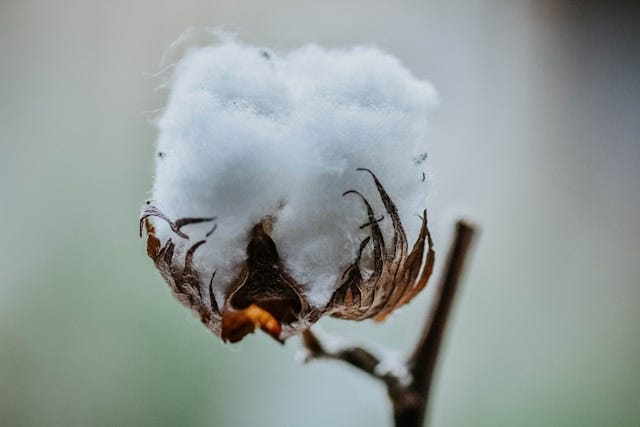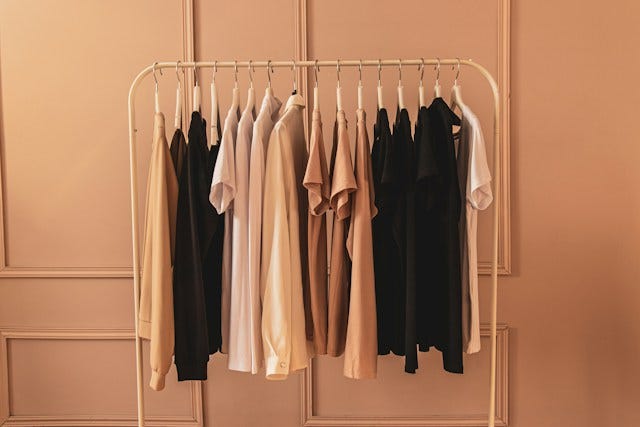Supima cotton forms 1% of the global cotton production.
Extra care is taken by the farmers to make sure the cotton harvested is of the finest quality and its production does not exploit the environment.
Supima cotton is superior to other kinds of cotton. In fact, Supima is a portmanteau of “superior” & “Pima” (another variety of super soft cotton).
If you are the scientific kind, then you’d love to know that it’s known as Gossypium barbadense among the geeks.

Photo by Yana Tes on Unsplash
Supima offers:
- Strength: Supima is twice as strong as regular cotton. The longer fibres resist pulling, breaking, and tearing, making them ideal for apparels that are made to last forever.
- Softness: Supima feels naturally softer and more luxurious because of its extra-long fibres. These longer fibres create smoother, cleaner yarns, making a fabric that stays soft and resists forming those annoying little pills. Apparel made from Supmia, therefore, feels incredibly soft, and what’s better? Like how fine wine ages and becomes better, Supima cotton becomes better, softer, and lustrous over time.
- Dye Retention: Supima’s finer fibres absorb dye with deep, long-lasting penetration. The result is a product that retains colour better than regular cotton. Supima products keep their brilliance wash after wash, giving you many years of use.
- Breathability: Its exceptional breathability sets it apart, making it an ideal choice for warm-weather clothing. This unique quality facilitates improved air circulation, preventing moisture from getting trapped between the fabric and the skin, ensuring unparalleled comfort and ease of wear.
- Traceability: If someone tells you they are selling 100% cotton t-shirts, is there a way for you to confirm? It’s impossible. From the naked eye or from the feel of the fabric, it’s hard to differentiate pure cotton from cotton mixed with synthetic threads. But if you buy a Supima T-shirt, you can track it back to the farm where it was grown. Isn’t that crazy?
- Eco-Friendly: It’s hard to get fabrics that respect nature and also maintain their original attributes for a long time. Supima farming uses practices that minimise the negative impact on nature. These include:
- Water Conservation: Cotton fields are laser-leveled to utilise water efficiently.
- Soil Conservation: Crop rotations to keep the soil nutrient-rich. GPS-guided tractors keep the vehicles on the same path.
- Focus on high yields and scientific methods: Periodic satellite imagery of Supima farms ensures that if there are any low-yield areas, then the reasons for such are identified, and necessary actions are taken. This laser focus on yields helps in reducing the wastage of natural resources.

Supima Farm — Source Supima Website
What’s the history of Supima?
Pima cotton gets its name from the Pima Native American tribe in Arizona, where it was initially cultivated in the early 20th century.
Trivia: Because of their lightweight durability, Goodyear Tire and Rubber Co. used Supima in their tire cords for their automobile tires. Before the tyre company commercialised Supima, it was farmed on small patches in the southern parts of the United States.
Supima’s journey began garnering attention in 1954 when American farmers, recognizing its growing demand, established the Supima organization. By then, Supima had already earned a reputation as the most luxurious fibre in America. However, its global acclaim surged in 1988, becoming the preferred choice for high-end spinners in Switzerland and Italy.
Today, Supima cotton reigns as the top choice for many fashion houses worldwide. It not only graces international markets but is also embraced by leading retailers and premium brands.

Source: Supima
What does the Farm to Fabric process of Supima look like?
After harvesting, Supima Cotton goes through a careful process to turn it from raw cotton into a luxurious fabric. First, the cotton fibres are separated from the seeds through a process called ginning, and then these fibres are spun into yarn. Because Supima Cotton has extra-long fibres, the yarn created is fine, strong, and has fewer joins, making the resulting fabric smoother and more durable.
The raw fabric then undergoes a thorough quality check to ensure it meets the high standards of the Supima brand. Once it successfully passes this strict inspection, it’s ready to be used in creating various products. Whether it’s bed linens, bath towels, clothing, or even denim, Supima Cotton adds a touch of luxury and durability to everyday items.
Where is Supima cotton fabric mostly grown?
Supima cotton cultivation is done in the United States, particularly in the southwestern states of California (93%), Arizona (3%), New Mexico (2%), and Texas (2%). The climate and soil conditions in these regions are found to be suitable for growing Supima cotton.
Where is Supima cotton fabric used?
- Apparel: High-quality T-shirts, Dress shirts, Polo shirts, Underwear, Pajamas and loungewear.
- Bedding and Linens: Bed sheets, Pillowcases, Duvet covers, Towels, Bathrobes
- Home Textiles: Curtains and drapes, Upholstery fabrics, Tablecloths and napkins,
- Accessories: Socks, Handkerchiefs, Scarves
What brands sell Supima cotton fabric products in India?
Supima cotton products can be purchased from many high-end fashion brands. Sattire brand is known for its super soft, lustrous, and pop-coloured Supima T-shirts. Uniqlo started using Supima for their premium T-shirts. March Tee in India is another brand that uses Supima in its apparel. Banana Republic, Levis, and Celio are all some of the leading brands using Supima.

Photo by piotr szulawski on Unsplash
Where can I find Supima cotton fabric Manufacturers in India?
Supima cotton fabrics are manufactured in all the major textile hubs such as Mumbai, Surat, Tirupur, Coimbatore etc.
Is Supima fabric costly?
Supima cotton is known for being one of the pricier cotton types, but this reflects its top-notch quality and guaranteed authenticity. Because the (American Supima Association) ASA carefully checks and certifies all Supima cotton, consumers are willing to pay more for this assurance.
In general, Supima cotton can cost about three to four times more than regular cotton, whether you’re buying fabric in bulk or finished products. Many people see the extra cost as a valuable investment for the guarantee of getting real, high-quality cotton.
Does Supima fabric require special care?
No. In fact, Supima gets better as it ages. The more you wash and wear it, the more you’ll feel the difference between Supima and other kinds of cotton.





